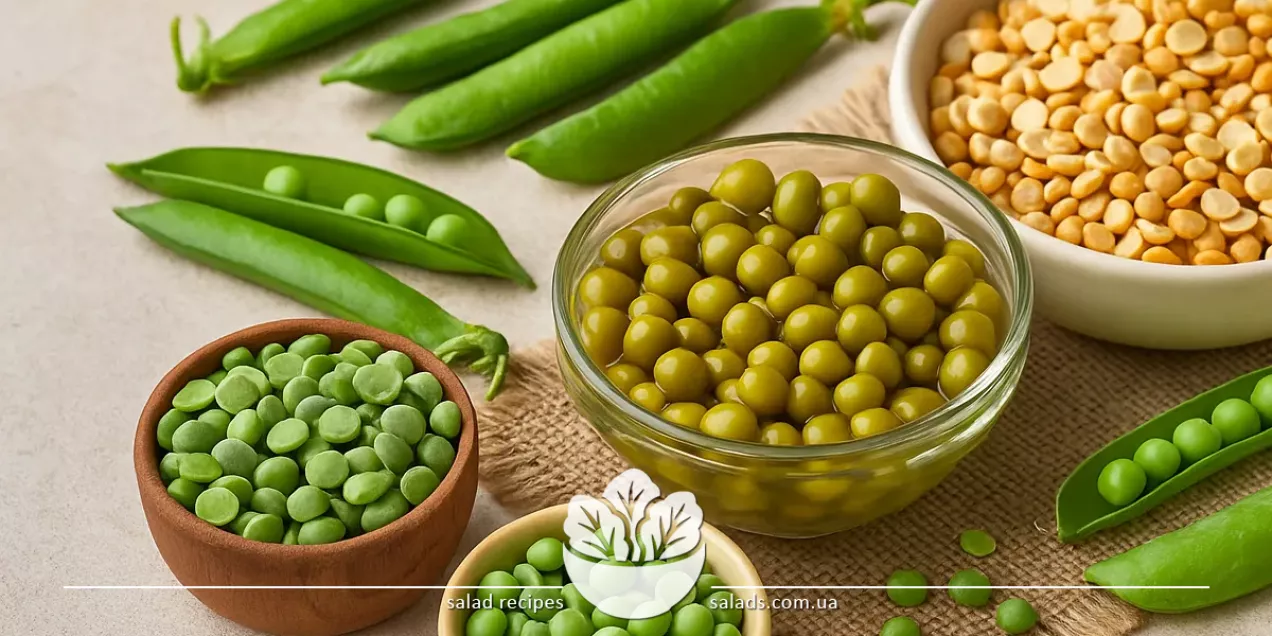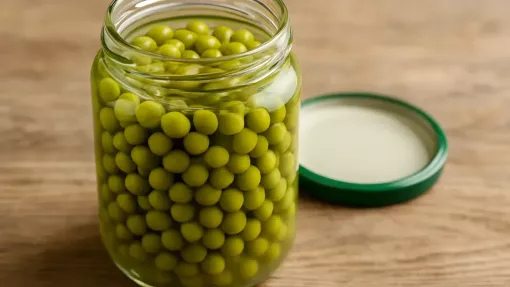Peas

Peas are a source of protein, fiber, and mild flavor that pairs perfectly with vegetable, meat, and vegetarian meals. They are available in several forms: young green peas, yellow dried, split, and snow peas. Each variety has its own culinary use – from soups to appetizers, from purées to side dishes. Peas are added to stews, salads, baked goods, and even cream soups. Learn more about vegetable ingredients in the vegetables category.
Different Types of Peas
Fresh Green, Snow, and Split Peas
Fresh green peas are young, slightly sweet grains harvested in early summer. Their tender texture and sweet flavor make them ideal for salads, soups, and side dishes. Green peas cook very quickly – they can be blanched or lightly boiled. They go well with mint dressing, butter, eggs, or dairy-based sauces. Snow peas (also known as snow peas or snap peas) are often used in Asian cuisine. They are eaten whole – pod and all. This type has a delicate, crisp texture and does not require long cooking. It is stir-fried in woks, added to warm salads, rice, or noodle dishes. This variety is great for dietary meals and looks bright and appealing on the plate thanks to its vivid color.
Split green peas (fresh, not dried) are sold without pods and are used in the same way as fresh peas – in soups, purées, or stews. They are easy to cook and have a soft, balanced flavor. They can be added to omelets, vegetable pancakes, stuffed pies, or steamed dishes. They pair well with other vegetables and even fruits such as apples or pears in complex salads. Peas also combine perfectly with cabbage – in soups, stews, and fillings for pies or dumplings. This duo creates a gentle, nourishing flavor suitable for both everyday meals and festive dishes.
Yellow Dried Peas and Their Culinary Uses
Yellow dried peas are one of the most popular ingredients in Eastern European and Asian cuisines. They come whole or split and are used to make soups, purées, porridge, patties, fillings, and even savory bakes. Unlike fresh peas, dried ones require soaking or long boiling. Thanks to their high protein and fiber content, pea-based dishes are filling and suitable for vegetarian diets. The most famous dish made from them is classic pea soup, often cooked with smoked meats, vegetables, and spices. Split yellow peas cook faster, making it easier to prepare a creamy purée – a traditional side in many countries. Pea purée has a smooth texture, mildly sweet taste, and goes well with herbs and spices. Dried peas are also ground into flour to make pancakes, flatbreads, or crackers. When combined with other legumes – such as lentils or chickpeas – peas form a base for plant-based protein mixes. A great combination is peas and onions, especially in soups, purées, or stews. Fried or caramelized onions add sweetness and depth to the flavor of dried peas.
Peas in Soups, Side Dishes, Salads, and Purées
Peas are a versatile ingredient that can serve as the base or complement in many recipes. In soups, they are often a key component: green peas in light spring vegetable soups and dried peas in thick, hearty winter dishes. Both vegetarian and meat-based versions with smoked meats or ribs are common. Peas cook down well, adding creaminess, body, and a delicate taste to soups. As a side dish, green peas can be served on their own – with butter, herbs, spices – or combined with potatoes, rice, and other vegetables. They are added to vegetable bakes, stews, and steamed dishes. Peas pair well with creamy or dairy-based sauces as well as fried components.
Pea purée is a classic side for meat, especially pork or poultry. It is made with butter, milk, spices, or fried onions. This dish retains heat well and stays filling for a long time. Pea purée can also serve as a breakfast base – as in the UK – or as a pie filling. Salads with green peas are a light and tasty option for any season. They are combined with boiled eggs, mayonnaise, vegetables, or grains. Green peas are especially common in festive salads and appetizers. Combined with sweet peppers, peas create a bright, textured, and flavorful combo for salads, casseroles, or soups. The peppers add freshness and color, while peas bring softness and nutrition.
Peas in World Cuisines: Tradition and Modern Use
Peas play an important role in many national cuisines. In Eastern European countries, dried peas are used in soups and purées, often served with smoked meats, onions, and croutons. This is traditional winter food – hearty, simple, and nutritious. In Poland, pea purée with fried onions is popular, while in Germany, it’s pea soup with sausages. In British cuisine, mushy green peas are a classic component of fish & chips. In France, young green peas are cooked with butter and mint – the dish known as petits pois à la française is served with veal, chicken, or fish. In Italian cuisine, peas are often added to risotto, pasta, and minestrone – a vegetable soup. Asian cuisines use peas in both fresh form (pods and young grains) and as paste. In China, snow peas are used in wok dishes, while in Thailand they appear in curries. In India, peas are the base for matar paneer (peas with cheese) and are used in chutneys, rice, and samosas. In Latin American cuisine, green peas are added to rice and meat dishes. In Cuba, peas are cooked with rice and spices; in Peru – used in soups with chicken and potatoes. Peas are often paired with tomatoes – in sauces, stews, or thick soups, creating a balanced and rich flavor.
How to Choose, Store, and Prepare Peas
When choosing green peas, look for a bright green color, firmness, and intact pods. They should be free of dark spots, wrinkles, or signs of over-ripeness. The grains should be tender, slightly sweet, and without tough skin. Fresh split peas should also appear juicy and smooth, with no signs of decay or dryness. Dried peas should be whole or evenly split, without mold, insects, or excess dust. Store them in an airtight container in a cool, dark place. They have a long shelf life but need to be sorted, rinsed, and usually soaked for several hours or overnight before cooking. This speeds up boiling and improves the final texture.
Green peas can be stored in the refrigerator for several days, preferably unpeeled. Pods are best kept in a perforated bag or container. After blanching, peas can be frozen, preserving their flavor and color for a long time. Before cooking, rinse and shell the peas if needed, chop or leave whole. Fresh peas cook very quickly – just a few minutes in boiling water or steamed. Dried peas take 30 to 90 minutes to cook, depending on the type. In prepared dishes, peas pair well with beans, forming a nutritious base for soups, purées, and stews.
